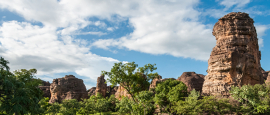Burkina Faso Weather, climate and geography
Weather & climate
Tropical. The dry season lasts from November to March and the rainy season from June to October. The best months are November to February when the Harmattan wind blows from the east producing dry and cool weather. However if you have allergies, avoid December to February as the Harmattan turns Burkina Faso into a dust bowl. Rainfall is highest in the southwest and lowest in the northeast. Avoid travelling in late March to May as the climate is too hot and dry to bear even for the locals.
Geography
Burkina Faso is situated in West Africa and bordered to the north and west by Mali, to the east by Niger, to the southeast by Benin and to the south by Togo, Ghana and Côte d'Ivoire. The southern part of the country, less arid than the north, is wooded savannah, gradually drying out into sand and desert in the north. The Sahara desert is relentlessly moving south, however, stripping the savannah lands of trees and slowly turning the thin layer of cultivatable soil into sun-blackened rock-hard lakenite. Three great rivers, the Mouhoun, Nazinon and Nakambé (Black, Red and White Volta), water the great plains. The population does not live in the valleys along the river banks due to the diseases prevalent there.
Do you have any Feedback about this page?
© 2025 Columbus Travel Media Ltd. All rights reserved. No part of this site may be reproduced without our written permission, click here for information on Columbus Content Solutions.




 You know where
You know where